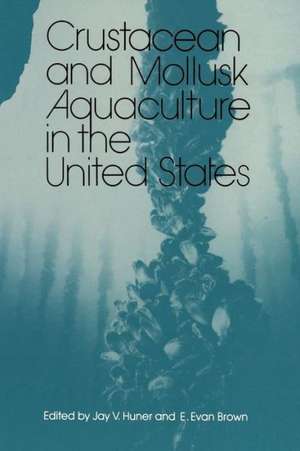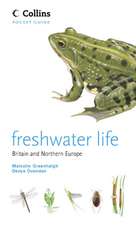Crustacean and Mollusk Aquaculture in the United States
Autor J.V. Huneren Limba Engleză Paperback – 24 feb 2012
Preț: 648.89 lei
Preț vechi: 763.40 lei
-15% Nou
Puncte Express: 973
Preț estimativ în valută:
124.16€ • 135.30$ • 104.63£
124.16€ • 135.30$ • 104.63£
Carte tipărită la comandă
Livrare economică 23 aprilie-07 mai
Preluare comenzi: 021 569.72.76
Specificații
ISBN-13: 9781468415056
ISBN-10: 1468415050
Pagini: 492
Ilustrații: 476 p.
Dimensiuni: 152 x 229 x 26 mm
Greutate: 0.65 kg
Ediția:Softcover reprint of the original 1st ed. 1985
Editura: Springer Us
Colecția Springer
Locul publicării:New York, NY, United States
ISBN-10: 1468415050
Pagini: 492
Ilustrații: 476 p.
Dimensiuni: 152 x 229 x 26 mm
Greutate: 0.65 kg
Ediția:Softcover reprint of the original 1st ed. 1985
Editura: Springer Us
Colecția Springer
Locul publicării:New York, NY, United States
Public țintă
ResearchDescriere
Crustaceans and mollusks are the glamor species of the seafood in dustry. Interest in aquaculture 1 of these invertebrates, frequently re ferred to as shellfishes, has resulted from increased exploitation of wild stocks. This has driven prices up to levels very attractive to investors. Much attention has been focused on crustaceans such as freshwater crawfishes, freshwater prawns, penaeid shrimps, and hom arid lobsters, and mollusks such as oysters, clams, mussels, scallops, and abalone. Success has been greatest with low trophic level species such as freshwater crawfishes and bivalve mollusks where nature subsidizes the aquaculturist in many ways, providing feed at low or no cost, seed for culture systems, waste removal, and so forth. Species such as homarid lobsters, penaeid shrimps, and abalone may have complicated life cycles, relatively slow growth rates, and other prob lems that have, so far, limited development of aquaculture of these high value, high visibility species. All taxa listed initially can be cultured from egg to egg in captivity, but many factors influence the commercial profitability of raising them in the United States. Investment in aquaculture of crustaceans and mollusks in the United States or by U. S. companies abroad has been extensive. Yet, only freshwater crawfishes and oysters have been cul tured on a truly large-scale, profitable basis to date in the United States proper. Other taxa such as penaeid shrimps and abalones are being cultured in the Orient where demand justifies expensive, labor intensive culture systems.
Cuprins
1 Crawfish Culture in the United States.- Species of Importance.- Basic Biology.- Diseases and Parasites.- Pond Culture.- Soft-Shelled Crawfish.- Intensive Crawfish Culture.- Status of Crawfish Culture.- Crawfish Processing.- Economics and Markets.- Summary.- Literature Cited.- 2 Freshwater Prawns.- Basic Biology.- Culture Techniques.- Diseases, Parasites, and Predators.- Constraints on Development of Prawn Farming.- Status of Culture in the United States.- Economic Overview and Outlook.- Literature Cited.- 3 Penaeid Shrimp Culture.- Species of Importance.- Basic Biology and Culture Requirements.- Culture Techniques.- Diseases and Parasites.- Status of Shrimp Farming in the United States.- Economic Overview and Outlook.- Literature Cited.- 4 Lobster Aquaculture.- General Biology—Selected Aspects.- Culture.- Diets for Larger Juveniles.- Diseases.- Site Selection and Design of Facilities.- Marketing and Associated Economics.- Future Prospects.- Literature Cited.- 5 Other Crustacean Species.- Blue Crab.- Cancer Crabs.- Spot Prawn.- Spiny Lobsters.- The Smaller Shrimps.- Literature Cited.- 6 Oyster Culture.- Natural History.- The American Oyster (Crassostrea virginica).- The Pacific Oyster (Crassostrea gigas).- The European Oyster (Ostrea edulis).- The Olympia Oyster (Ostrea lurida).- Oyster Hatcheries.- Problems Facing the Oyster Culture Industry.- Summary.- Literature Cited.- 7 Clam Aquaculture.- Clam Fisheries and Aquaculture Production.- Basic Biology.- Culture Techniques.- Parasites and Diseases.- Constraints.- Status and Economic Overview.- Summary.- Literature Cited.- 8 Mussel Aquaculture in the United States.- European Mussel Culture Technology.- Feasibility of European Culture Techniques in the United States.- Current Mussel Aquaculture Production.- Recent Research Efforts.- Life Cycle of the Blue Mussel.- Experimental Culture—East Coast.- Experimental Culture—West Coast.- Presence of Pearls.- Predation, Parasitism, and Accumulation of Algal Biotoxins.- Mussel Culture in Heated Effluents.- Aquaculture Carrying-Capacity Model.- Economics.- Summary.- Literature Cited.- 9 Abalone: The Emerging Development of Commercial Cultivation in the United States.- Principal U.S. Species.- Biology.- Conventional Cultivation Technology.- Barriers to Efficient Production Using Conventional Technology.- Ocean Ranching.- Summary and Prospects for Future Industrial Development.- Literature Cited.- 10 Water Quality.- Physical Variables.- Chemical Variables.- Biological Variables.- Pesticides.- Water Analysis.- Literature Cited.- Appendix: The Brine Shrimp, Genus Artemia.





